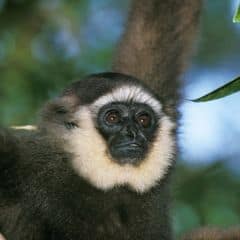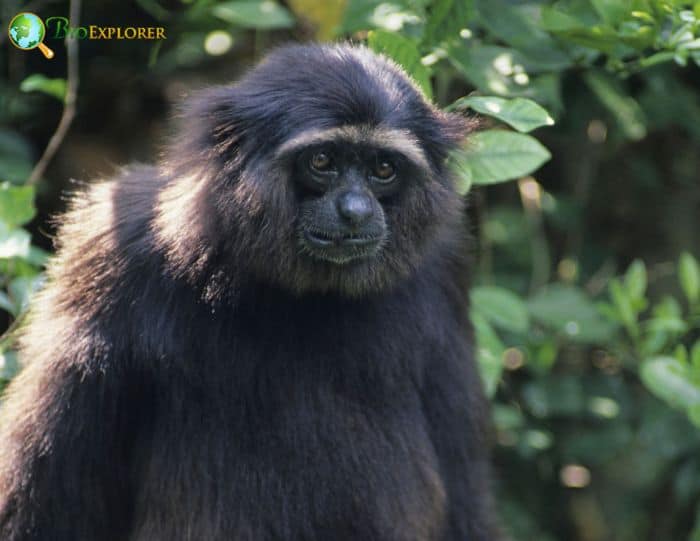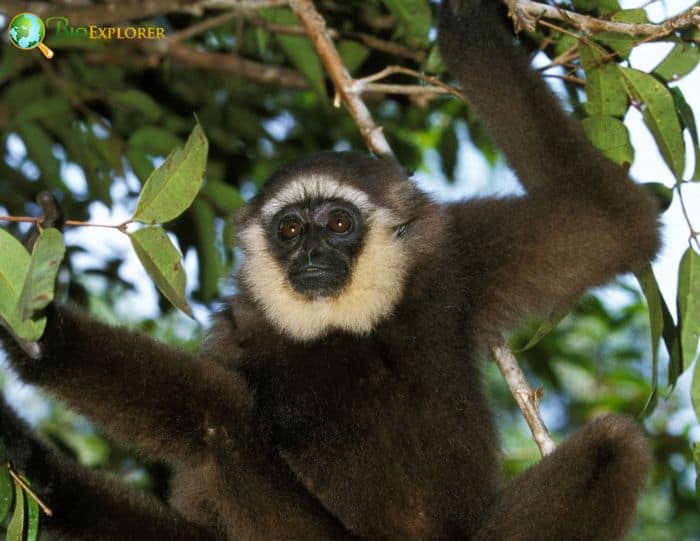
| Animalia | Primates | Hylobatidae | Hylobates | Hylobates muelleri |


- Common Names: Borneo Gibbon, Müller’s Gibbon, Gary Gibbon
- Taxonomy Classification Year: 1841
- Monkey Size: 44 to 64 cm (17 to 25 in)
- Skin Color(s): Light brown
- Habitat: Forest, rainforest
- Diet: Herbivorous
- Native Countries: Indonesia, Malaysia, Brunei
Borneo gibbon Distribution
Bornean Gibbon Characteristics

Also known as the Müller’s or gray gibbon, the Bornean gibbon[1] is native to the Bornean Island, which is divided between the nations of Brunei, Malaysia, and Indonesia.

- They have light brown fur that fades to black on the face, chest, and inner arms, with a white border around the face.
- They have padded buttocks and pronounced canines, and the base of the thumb unusually starts at the wrist rather than the typical palm of the hand, enabling them a wide range of motion.
- However, this limits their ability to grasp small objects. One of their most distinctive features is their incredibly long arms, especially their long ulna and forearms’ radial bones.
- This trait, along with many other minor skeletal adaptations, tailors the species to its method of locomotion: brachiation.

What Do Borneo gibbons Eat?

The Borneo gibbon diet includes Jointfir (Gnetum), Breadfruit (Artocarpus) and Mangoes (Mangifera)[¶].
Bornean Gibbon Facts

- Although every Borneo gibbon song sounds similar to a human, they are very individual. Computer analysis can identify individual female species from their songs with an accuracy of 95.7%.
- These primates are very territorial. Their range averages 34 ha (84 acres), and around 75% of this area is actively defended.
- Usually, Borneo gibbons live in groups of 3 or 4, a pair and their young.
- They are active between 8 and 10 hours a day. They are diurnal, waking up just before sunrise and falling asleep at night before sunset.
- Borneo gibbons spend little time socializing: they spend only around 5 percent of their day grooming and socializing, which is considerably low for a primate species.
Suggested Reading: All Types of Apes
Cite This Page
APA7MLA8Chicago
BioExplorer.net. (2025, April 14). Bornean Gibbon. Bio Explorer. https://www.bioexplorer.net/animals/mammals/apes/bornean-gibbon/.
BioExplorer.net. "Bornean Gibbon" Bio Explorer, 14 April 2025, https://www.bioexplorer.net/animals/mammals/apes/bornean-gibbon/.
BioExplorer.net. "Bornean Gibbon" Bio Explorer, April 14 2025. https://www.bioexplorer.net/animals/mammals/apes/bornean-gibbon/.










